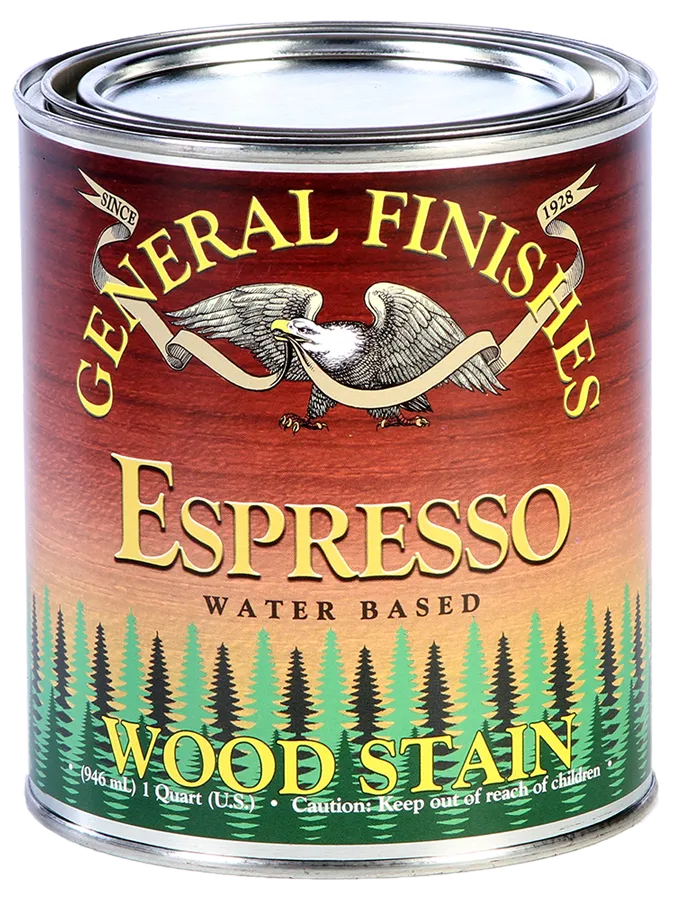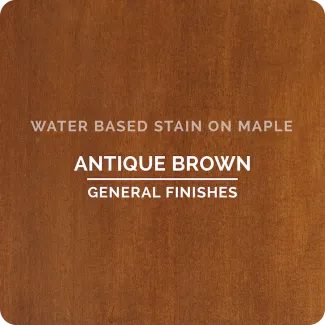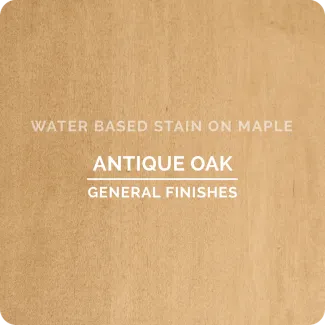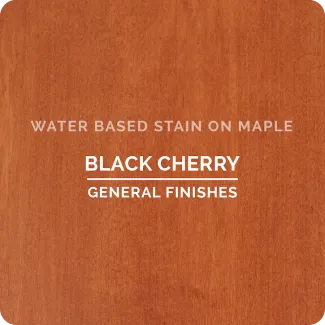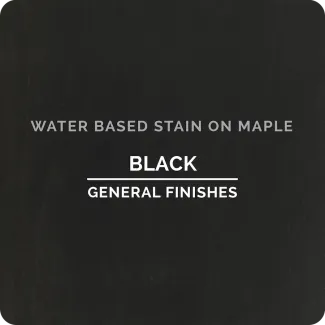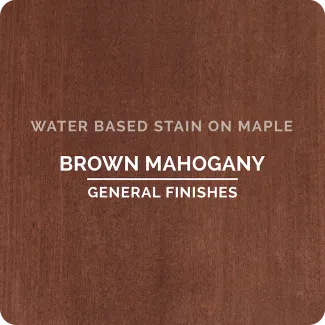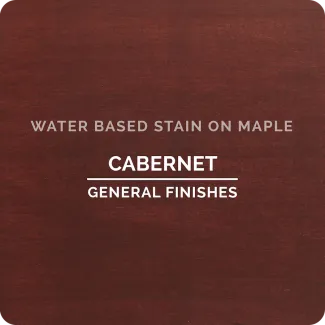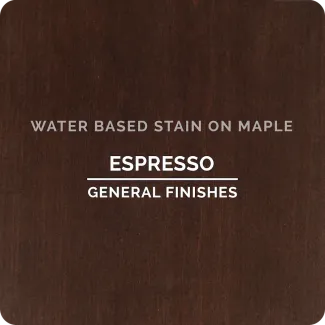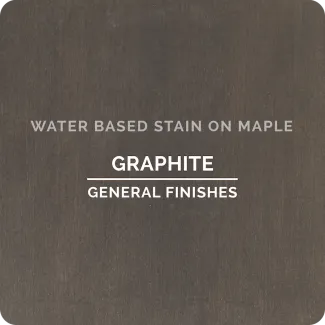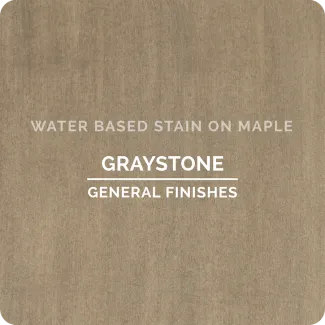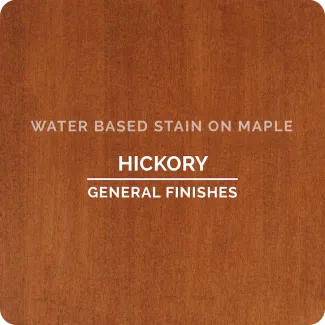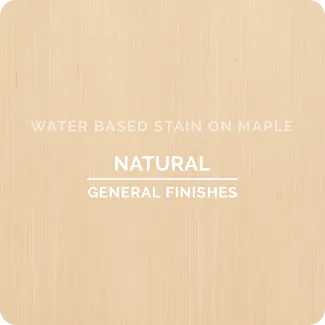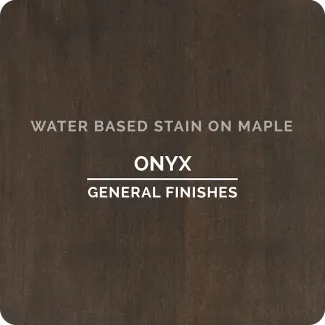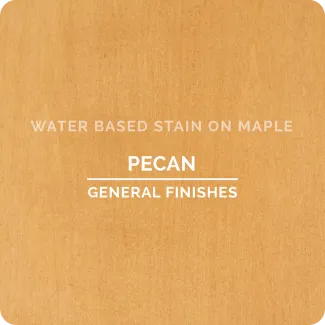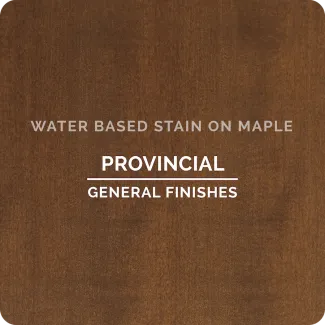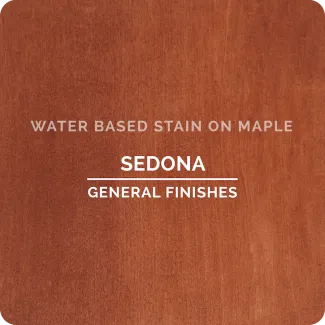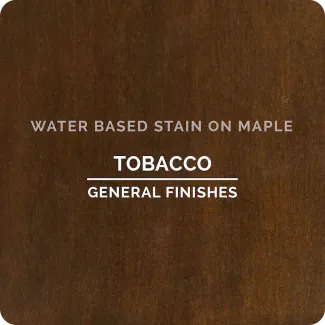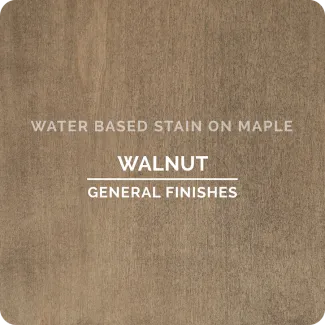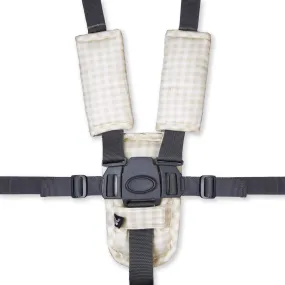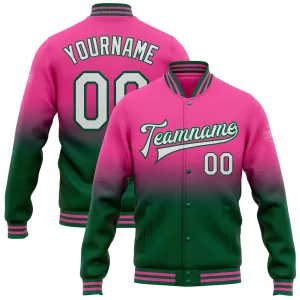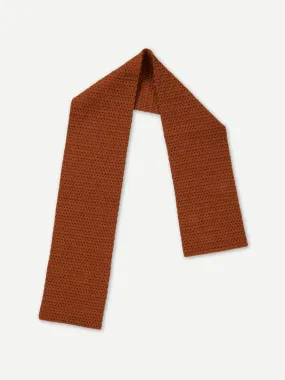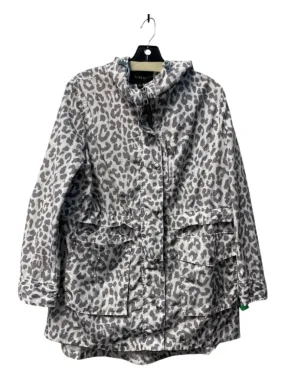General Finishes Water Based Wood Stains are formulated to provide workability similar to oil-based stains. They spread easily, can be repaired and have plenty of open time. The thicker formula of these wood stains allows for controlled penetration. Their high-quality pigments produce rich, dark, uniform colors on hard-to-stain woods like maple and pine. Our wiping wood stains are low odor, low VOC, water cleanup and noncombustible.
Please click the below headers to reveal the instructional info for this product.
Step 1: Preparation for Water-Based Wood Stain
Before applying stain, all raw wood projects require preparation sanding, and all existing finishes require prep cleaning and sanding. If you skip this critical step, your finish may fail.
Preparation for Raw Wood Projects
- Sand open-grain wood (e.g., oak, ash, mahogany, parawood) with 120-grit sandpaper, followed by 150-grit, then 180-grit.
- Sand closed-grain wood (e.g., cherry, pine, maple, birch, alder) with 150-grit sandpaper followed by 220-grit.
- Remove dust with a vacuum, compressed air, an oil-free tack cloth or a water-dampened rag.
- Do not over-sand with fine-grit sandpapers; this will close and seal the wood grain, preventing ideal color absorption.
- Do NOT use steel wool with water-based finishes; the particles will get trapped in the finish and rust.
Reducing Grain Raise on Raw Wood
To reduce grain raise, dampen the wood with water after prep sanding. Let dry completely, then lightly sand with fine-grade (220-320) foam sanding pad.
Preparation for Projects with an Existing Finish
For high-use areas with heavy grime build-up and oil from hands, give your project a deeper cleaning.
- Scuff clean with a Scotch-Brite™ pad or maroon synthetic steel wool and a 50:50 mix of denatured alcohol and water. Avoid cleaning with products containing phosphates (salt), which can linger in the substrate and produce a white haze. If your project requires a deeper cleaning, see Power Prep Cleaning Highly Used Existing Finishes below.
- Dry 1-2 hours.
- Sand lightly with a fine-grade (220-320-grit) foam sanding sponge or 400-grit sandpaper.
- Remove dust with a vacuum, compressed air, an oil-free tack cloth or a water-dampened rag.
- Let dry completely before applying General Finishes product.
Power Prep Cleaning Highly Used Existing Finishes
- Scrub clean with a detergent, such as Spic and Span or Dawn, using a Scotch Brite™ pad.
- Rinse well with water.
- Scrub clean with a Scotch Brite™ pad and a 50:50 mix of denatured alcohol and water. Dry 1-2 hours.
- Sand lightly with a fine-grade (220-320) foam sanding pad.
- Remove dust with a vacuum, compressed air, an oil-free tack cloth or a water-dampened rag.
- Let dry completely before applying General Finishes product.
Alternative Cleaning Solutions for Existing Finishes (Not as aggressive or effective as denatured alcohol; requires rinsing.)
- 50:50 mix of bleach and water
- 50:50 mix of vinegar and water
- Mineral spirits can be used when working with water-based products, but only if the surface is thoroughly rinsed and allowed to dry for 72 hours.
Step 2: How to Apply General Finishes Water-Based Wood Stain
General Finishes Water Based Wood Stain Application Steps
- Work in a well-ventilated area.
- Stir stain to reincorporate solids that have settled to the bottom of the can before and throughout the application process.
- Thin as desired with distilled water; start with 5%, adding up to 10% by volume.
- Increase open time, if needed, with up to 5% if allowed by local regulations. will improve flow and leveling and increase open time, which is helpful in dry climates. California Residents: Adding more than 2% of will make the products non-compliant per SCAQMD Regulations. GF assumes no liability for the improper use of these products.
- An initial coat of General Finishes Pre-Stain Conditioner Natural can improve color uniformity over difficult-to-stain wood species such as pine. However, it will limit color absorption, so a darker stain may be required to get the depth of color you want.
- Test your complete finishing process beforehand. Stain color can be affected by variances in wood, room lighting, and deepened with the application of topcoat.
- Surface preparation is essential. See "Step 1: Preparation for Water Based Wood Stain."
- Divide your project into manageable sections: top, side, drawer, door, table seam.
Hand-Application over Raw Wood
- Apply a LIBERAL amount of stain to ensure easy workability using a synthetic bristle brush, foam brush, pad applicator or roller. Work quickly. If not enough stain is used, the surface may dry too quickly, causing an uneven appearance. On large projects, leave a wet edge between sections to prevent lap lines.
- Stain one complete section at a time.
- Wipe off the excess evenly with the grain using cloth or an absorbent paper towel. Check for missed spots and lap marks before moving to the next section. Do NOT use cotton t-shirts to wipe away stain because they will "push" the stain around and not absorb it.
- Pull excess stain out of corners and details with a synthetic bristle brush.
- Immediately correct lap marks by rewetting the entire working area with stain and wiping off the excess.
- Let the stain dry 2 hours in ideal conditions: 50-70% humidity, 70°F/20°C before adding a second coat (optional) and before adding topcoat. Be sure to allow adequate dry time. If in doubt, wait longer. Increase dry time if:
- Humidity is over 80%
- 3 coats are applied (not recommended)
- Thick coats are applied
- To accelerate dry time in humid conditions, add General Finishes Accelerator before applying and work in a space with good ventilation and air movement. If you decide to re-coat before the recommended time, test dryness.
Spray Application over Raw Wood
- Before spraying, strain topcoat through a fine-mesh filter.
- Safety: Wear a full filter respirator (NIOSH/MSHA-approved) and work in a ventilated space.
- Spray wet films at 3-5-mil thickness. HVLP: 1.1mm-1.3mm spray tip, medium air cap. Verify tip sizes with your equipment supplier. Keep your gun at a 90° angle, 6-8" from the surface. On large, flat areas, use wet, even patterns 6-8" wide. For narrow surfaces, reduce the fan pattern to 2-3" wide to reduce overspray. Overlap each pass 25-50% for even coverage. Spray a LIBERAL amount of stain to ensure easy workability. If not enough stain is used, the surface may dry too quickly, causing an uneven appearance. On large projects, leave a wet edge between sections to prevent lap lines during application.
- Pull excess stain out of corners and details with a bristle brush.
- Immediately correct lap marks by rewetting the entire working area with stain and wiping off the excess.
- Let the stain dry 2 hours in ideal conditions: 50-70% humidity, 70°F/20°C before adding a second coat (optional) and before adding topcoat. Be sure to allow adequate dry time. If in doubt, wait longer. Increase dry time if:
- Humidity is over 80%
- 3 coats are applied (not recommended)
- Thick coats are applied
- To accelerate dry time in humid conditions, add General Finishes Accelerator before applying and work in a space with good ventilation and air movement. If you decide to re-coat before the recommended time, test dryness.
Hand-Application over Existing Finish
- Stir contents well.
- Prepare surface well. See Existing Finish Prep instructions in "Step 1: Preparation for Water Based Wood Stain."
- Apply stain with a foam brush or paint pad. Feather out uneven areas and pull excess stain from corners using a bristle brush. Discharge accumulated stain from the brush onto a dry paper towel as you work.
- Let the stain dry 2 hours before GF water-based topcoat in ideal conditions: 50-70% humidity, 70*F/20*C before applying a second coat (optional) and before applying topcoat. Be sure to allow adequate dry time. If in doubt, wait longer. Increase dry time if:
- Humidity is over 80%
- 3 coats are applied (not recommended)
- Thick coats are applied
- Applying over products from other brands
- Layering General Finishes water- and oil-based products:
- Water over oil: Let oil-based products dry 72 hr before applying water-based products
- Oil over water: Let water-based products dry 24 hr before applying oil-based products
- To accelerate dry time in humid conditions, add General Finishes Accelerator before applying and work in a space with good ventilation and air movement. If you decide to re-coat before the recommended time, test dryness.
- Topcoat is required. Finish with 3 coats of General Finishes topcoat. See "Step 3: Topcoat Over Water-Based Stain."
Step 3: Topcoat Over Water-Based Stain
Always seal General Finishes Water Based Wood Stain, General Finishes Dye Stain and General Finishes Enduro Ready-To-Match (RTM) Water Based Wood Stain with 3 coats of topcoat. More coats will not improve durability.
Recommended Water-Based Topcoats
General Finishes High Performance can be applied by hand or sprayed; General Finishes Enduro Clear Poly is spray-only. Both topcoats dry clear and are great for high-use surfaces, such as kitchen cabinets and tabletops. General Finishes Flat Out Flat is our flattest topcoat, suitable for projects that do not receive major wear.
Recommended Oil-Based Topcoats
When sealing with General Finishes oil-based topcoats, General Finishes Arm-R-Seal and General Finishes Gel Topcoat, let water-based stain dry a minimum of 24 hours first. Oil-based topcoats amber increasingly over time.




